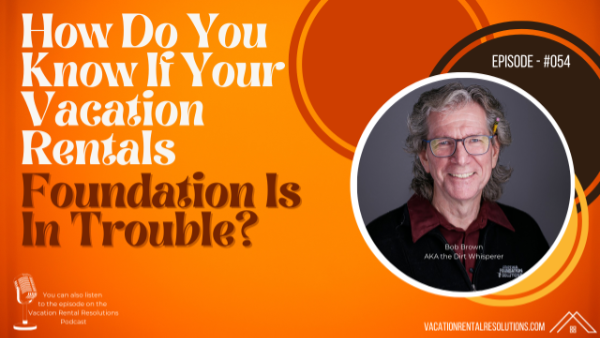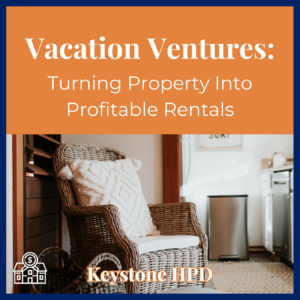Table of Contents
- 1
- 2 Wondering if that crack in the wall means your property is on the brink of collapse? Relax, Bob Brown has you covered.
- 2.1 In the interview, Bob reveals what to look for in your vacation rentals foundation to know if it’s truly a cause for concern.
- 2.2 Creating a Vacation Rental Virtual Tour That Converts Browsers into Bookers-102
- 2.3 How Do I Find Local Influencers Who Match My Rental’s Vibe?-101
- 2.4 How to Use Colour Psychology to Boost Bookings-100
- 2.5 How Do I Build My Vacation Rental Social Media Toolkit-099
- 2.6 How Do You Create a Vacation Rental Brand Personality-098
- 2.7 How to Wow Your Guests with Unexpected Touches-097
Wondering if that crack in the wall means your property is on the brink of collapse? Relax, Bob Brown has you covered.
In the interview, Bob reveals what to look for in your vacation rentals foundation to know if it’s truly a cause for concern.
Today, we’re tackling a topic that most of us don’t fully understand but fear nonetheless – property foundations. I had the pleasure of sitting down with Bob Brown, AKA the Dirt Whisperer, who has spent over two decades in the foundation repair industry. Not only is Bob an expert with numerous patents to his name, but he’s also on a mission to change how the industry operates.
If you’re a vacation rental owner or just curious about what’s holding up your property, this conversation is packed with insights.
Let’s jump in as Bob shares his journey, his secrets, and some much-needed advice on keeping your foundation solid!
Gerry:
Our chat today is with Bob Brown, AKA the Dirt Whisperer. And today we’re going to talk about property foundation, something that we’re all a little nervous about, and to be honest, most of us don’t know anything about. Bob, you have an amazing history in the foundation industry, and I really appreciate you taking the time to share your expertise with us.
Bob:
Hey, I’m happy to be here.
Gerry:
Super. Okay. All that being said, you ready to jump into this?
Bob:
Absolutely.
Gerry:
Now, before we get into the nitty-gritty of everything and you tell me I don’t have to worry about the crack in my foundation, how did you get into the foundation industry business?
Bob:
I graduated from Arizona State University with degrees in finance and architecture, and I had a little, the way I worked my way through college just doing small concrete repairs, [00:01:00] and so as a result, I became an expert in concrete. Concrete repairs led to one another. I started looking at mud jacking and slab jacking and trying to be innovative and differentiate myself. And along came a national supplier of products for foundation repair and said, “Hey, we’re looking for an exclusive dealer in your area.” Would you like to be it? And I said, sure. So, that’s when I really didn’t know much about it. At that point, I didn’t know much about soils. I didn’t know much about foundation repair. They basically taught us pretty much everything.
I basically learned the foundation industry, like everybody else in the business, from my single-source supplier. So, they told me what soil problems were. They told me how to fix it. And of course, they would always tell me that the solution was their solution. So basically, all of these suppliers teach foundation repair installers to recognize problems through the lens of their solutions, which helps them sell lots of products. But it doesn’t really help homeowners or property owners to have an objective view about what the problem is and how to really fix it. It’s really not the right way to go about it.
Gerry:
Is this when you got into foundations?
Bob:
That was about 2000. So 24 years ago.
Gerry:
All right. Okay. For us laypeople, what exactly is a foundation?
Bob:
Sure. There are different kinds of foundations, and a lot of it depends on what part of the country you’re in. Down south, in the southern states. Yeah. In the States. Correct. I don’t know worldwide. I think it probably applies to Australia too, but they have what they call slabs on grade, which is basically, there’s a couple of different variation types of that, but it’s a slab with a perimeter footing. And a footing is basically a strip of concrete that’s down lower and thicker and has reinforcing in it.
And the roof loads on modern buildings have trusses that bear all the load to the edges, and then they’ll go down the walls to that footing. So the slabs really don’t take much weight. People think that the slab’s the foundation, which isn’t really true. Post-tension foundations are a monolithic slab and footing with the cables both ways, and they tighten them up. So the slab is a part of the foundation, but most of the time, it is not. Then you get a little colder areas, and you have what they call a crawl space. You have the same footing, it goes around the perimeter, but for a floor, you have a wooden framed member with joists and then some interior jacks that hold it up, and that’s called a crawl space.
And then you go to even colder locations, and you have a basement. The basement will have a footing around the edge of it again, and a slab, and then it will go up to the walls, and then you’ll have your dirt level, and then you have your either masonry or framing on top of that. Those are the three basic kinds of foundations: slabs on grade, crawl spaces, and basements.
Gerry:
Okay. Are there any misconceptions about foundations?
Bob:
Oh, boy. One of them I already talked about is people think that their floor is their foundation. Most of the time, it’s not. But a lot of times, people get scared about foundations. You see a crack in your wall, you think your house is going to fall down, right? No. First of all, one crack hardly means anything. What I look for is a pattern, a grouping, a pattern of cracks, sloping floors, maybe doors and windows that are out of square. What I mean by that is, if you look between the, where it shuts between the top, it’s that on one end, and on the other end, it’s skinny, it’s pinched. The same thing can happen with windows, and that usually means that it’s moving like this, and it’s pinching it. Once you get a pattern of all of this kind of thing together, then that indicates that, yeah, there’s some footing movement going on.
Now, what does that mean? Does that mean it’s all lost? No, absolutely not. First of all, it could be done moving. You don’t know. You need to talk to a geotechnical engineer, and he can give an opinion about whether it’s done moving or not. Anybody else who tries to opine on that is BSing you. It’s common in the foundation repair industry to send out salespeople to analyse this. Analyse foundation problems, but these guys really have no formal education in soil mechanics or structural load paths or any kind of engineering. They don’t, and they’re paid on a commission basis. 100 percent commission, which means that if they sell nothing, they get nothing. And these guys are very successful. I had 20 of them in my company before I sold it back in 2023. And the fact of the matter is, these guys typically earn somewhere between $100,000 and $300,000 a year. They’re very well paid. It’s a secret. And if they don’t make at least $100,000 a year, they’re usually kicked to the curb. They usually let them go. So there’s a lot of pressure to sell. And these guys – there’s no oversight. There’s no regulatory branch of government that oversees their analysis or designs. So they’re just free to run amok and tell people whatever they want. There are no checks and balances in place for any of it.
Gerry:
That’s scary, actually.
Bob:
Exactly. So the moral of the story is, if you see a pattern of problems – I’m talking about sloping floors, cracks, doors, and windows – you see a pattern of that, don’t call a foundation repair company for the analysis. Call a forensic geotechnical engineer. And yeah, it won’t be free. But it’s also not going to – he’s not going to try to sell you $80,000 of foundation repair products in order to get a commission, because he’s got no dog in the fight. And engineers have a code of ethics that they have to follow, and they’re held accountable by their state boards of registration. You’re going to get the real, honest-to-God truth with a forensic geotechnical engineer. They’ll tell you, yeah, you’ve got a problem, or no, you don’t have a problem. And if you do have a problem, they’ll design the repair, and you can send that out to three contractors and get three bids.
But what happens today? You call three foundation repair contractors. One guy tells you, you need five piers over here. The other guy tells you, you need 15 over here. The third guy tells you, you need 25 all the way around. You’re not the expert. How are you supposed to figure out which one’s right? It’s crazy. You have no idea which one is really right. So who do you go with? You go with the one that you’re most comfortable with, which is probably the best sales guy.
Gerry:
Yeah, which –
Bob:
Is probably the least qualified to be an engineer. You don’t want to go down that road. That analysis is free. Those guys will come out, they’ll pretend like they’re doing lots of analysis and give you a little report with pretty pictures. It doesn’t mean anything. It’s just the opinion of a guy trying to make a sales commission.
Gerry:
That’s fascinating and scary.
Bob:
Yeah, exactly.
Gerry:
So how hard is it to find a forensic engineer?

Bob:
It’s pretty hard. That’s the other problem. I’ve created a directory on my website, Foundation Repair Secrets. You can find – and I’ve got it listed geographically by state. Now, I haven’t vetted these guys. I’ve just found them with Google searches and gone onto their website and tried to figure out that. Yeah, do they do residential work? Do they do forensics? Do they do foundations? And I’ve tried to figure out which ones would offer this service. Most engineers work in infrastructure. Most engineers do things like freeways and dams and big infrastructure kind of stuff. Some of them work in commercial buildings. Very few work in residential, and of those, very few do forensics. So they’re really hard to find. And what I’m trying to do is encourage more of them to offer this service. And I’ve got a few taking me up on it. But it’s going to take some time, but in the meantime, feel free to use the directory – just, with the caveat that they may or may not do it exactly the way that it ought to be done. I don’t know. But it’s better than nothing. It’s better than getting something for free from a contractor that’s trying to sell you something.
Gerry:
So basically, do your research.
Bob:
Yeah, exactly.
Gerry:
Okay, let’s do a hypothetical here. I’m buying a property and I want to turn it into a, I don’t know, a B&B or a vacation rental, or even a small independent hotel. I’m thinking about the foundation. I don’t know a lot. What would be my first step?
Bob:
What I would do is I would make an investment in a forensic geotechnical engineer. Now, if you’re on the selling side, by the way, I would give you the same advice: before you put it up for sale, call one of these guys and get a clean bill of health with a seal on it that you can show, in case any inspector decides to call something out and think that there’s a big problem, right? Then you can show them this. Or if you need repairs, get them done and then put a seal on it saying everything was done right, and you can show that to people. It’s a little harder when you’re on the buying side. But it’s worth the investment, especially if it’s a considerable sum of money, like in a small hotel. Usually, the due diligence on those is a little longer, a little more in-depth, right? A little more difficult with a house – it’s hard to justify spending a grand on something you may or may not buy, right? But I believe it’s worth the effort, especially if you see a grouping of problems.
If you don’t see the grouping of problems, it could be that somebody covered it up, and that does happen. But one piece of advice I give people is in the contract – the buyer, the purchase contract – make a clause that says, hey, if the inspector sees a problem, if he sees a grouping of these problems, we get an extra time period – two, three weeks – to find a forensic engineer, investigate, and then come up with a report so we can be well-served. What happens most of the time is the inspector comes up with his report, gives it to the owner, and there are two days left in the inspection window. It’s like, what? I’ve got to find an engineer and get a report in two days? That’s impossible. That’s just not going to work. I would also suggest having a good relationship with these forensic engineers ahead of time so that you don’t have to go scrambling, searching, and all that stuff. Have a relationship with them, take them to lunch or whatever. Get to know them. Have a good relationship with a forensic engineer, so that when you’ve got a project, you can say, “Hey, I’ve got something I’d like you to look at.” They won’t give you the runaround, and you can save a lot of time, effort, and brain damage that way.
Gerry:
Oh, that’s an excellent idea. Actually, I encourage any property owners to build a list of basically partners that they can do that with, right? So, I’m adding that to the list.
Bob:
Yeah, definitely add that to the list. It’s a really important relationship to have. As a matter of fact, I tell agents all the time that you can carve a little niche out for yourself by being known to have relationships with these guys and being able to handle the problems professionally, maybe in a way that some of your competitors don’t. So it’s a little niche for them.
Gerry:
Oh, that’s a good idea. Okay, I’ve heard – actually, I was dealing with a realtor once, and they mentioned a term that I hadn’t heard before, and I’m going to ask you. You might not know it, but in case you do – severity scale.
Bob:
Sure.
Gerry:
Have you heard that term?
Bob:
Oh, I talk about that a lot. Let me tell you about the severity scale.
Gerry:
Okay.
Bob:
How bad is bad? How bad is it? Is it bad enough to spend $80,000, or can I just let it go and not much will happen? When people have these questions, when they see these problems, those are the kinds of questions they have. How bad is it? Is it going to continue to get worse? What happens if it does get worse? They have all these questions. If you’re asking those questions to some guy who wants to sell you a repair at a commission, what do you think his answer is going to be?
I’ve heard them say things like, “Mr. Jones, on a scale of 1 to 10, I think your foundation problem is about an 8.5.” And I’m thinking to myself, okay, what scale is that? Is that like the Richter scale of foundation repair? What is that? And how did you arrive at 8.5? “Based on my experience and the fact that my kids need braces” – it’s a total BS scale.
So how do you find a severity scale? Now, in the professional industry, there’s a little bit of debate about this going on right now, but the Post-Tension Institute and the Foundation Performance Association, two professional organisations, have come up with a severity scale that uses tilt and deflection with allowables.
Okay, tilt. So tilt is when you’re tilting, right?
Gerry: And?
Bob:
If you tilt more than 1 percent, then you fail. Now, 1 percent doesn’t sound like a lot, but it’s a lot. On a typical house, you’d have to be more than seven inches out of level to fail. That’s quite a bit. You don’t run into that very often. It happens once in a while, but not very often. Now, deflection is deviation from a straight line. Instead of being flat, it’s got a bulge or a dip or something – the ends falling off, some sort of deviation from a straight line. They use an allowable called L over 360. Now, what does that mean? That means that for 360 inches, you’re allowed one inch of deviation. If you have more, you fail. And it’s backwards because the L is on top, so it’s a fraction. And the way it works is, if it’s less than 360 inches, then you fail. And so, L over 360 – now, there’s some, a lot of controversy about this. I will tell you, a lot of engineers recognise that there are some problems with this standard. There’s technical stuff that I don’t want to get into and bore everybody to death, but there is a little bit of debate, and there are some alternate proposals being bandied about. But the engineers do have standards that they can use.
If you ask a foundation repair person, “Okay, what’s the tilt and deflection? What standard? Are you using the PTI standard?” they’re going to look at you and go, “Oh, I have no idea what you’re talking about,” because they don’t. They’re not professionals.
Gerry:
Okay, that made me nervous. If I want to learn more about that, if I followed you, is that the kind of information that I could get from you?
Bob:
Absolutely. So a couple of things. I wrote a book. It’s a bestseller on Amazon, same title as my website, Foundation Repair Secrets. You can learn a lot there. You can get to my newsletter, where I talk about this kind of stuff in my blogs all the time.
Gerry:
Oh, super.
Bob:
And if you subscribe to the newsletter, you can get “The 15 Myths of the Foundation Repair World as it Relates to Real Estate” and “10 Common Mistakes That Real Estate People Make.” Those are available, and I encourage people to become educated, understand how this works, and don’t be taken advantage of. One of my favourite sayings is, “Sometimes, if the only tool you have is a hammer, then all your problems start looking like nails.” And that’s a very common thing that happens in the foundation repair industry. They come out, they see a bunch of cracks, and say, “Okay, let’s use the solution that my supplier told me to use.” What I tell people is, don’t get nailed by those who only have one solution to offer.
Gerry:
Good advice. Now, I read that you have some patents. True? Tell us about them.
Bob:
Yeah, I do. I’ve developed a couple of really cool ideas over time. They’re a little bit technical for people in the non-industry, but one of them involves repairing concrete that has rusting rebar in it. Sometimes you’ll see a crack right along near the bottom of the foundation going around the perimeter. It’s a horizontal crack and very continuous. That’s usually the rebar rusting. When it rusts, it gets bigger, puts pressure on the concrete, and cracks it. I’ve developed a solution using composites that uses composite rebar, composite hold-down straps, composite jacks, composite J-bolt replacements – the whole nine yards.
Gerry:
Wow. You’ve been busy.
Bob:
Another patent that I have is for a needle pile. When you have a floor and you want to drill a pile through the floor, it’s a very small diameter pile. Typically, the industry has to cut these great big holes in the floor, which destroys the slab. You put the pile down, and then you can lift the slab up and solve all the problems.
I also have a patent for the moisture level system. It dries out heaving clays under an existing foundation using airflow. The airflow goes through the gravel layer right under the slab, and it dries out the clay soils beneath it. I also have a patent for some software I developed. Engineers use it, foundation repair contractors use it, and it involves a whole 3D viewing system and a report system – the whole ball of wax – to help them do a good report.
Gerry:
Wow, you’ve been busy.
Bob:
Yeah, I’ve got a lot on my plate.
Gerry:
Okay, the weather’s been changing dramatically for a while now. Has that affected your industry?
Bob:
Probably not in Arizona. It just gets hotter here.
Gerry:
Yeah, okay.
Bob: I hate to say it. We don’t get hurricanes, we don’t get tornadoes, we don’t get earthquakes, and we don’t get fires, at least not down in the Phoenix portion. Up north, we do, but down here, not much. If you’re along the Gulf Coast, though, yeah, you’ve got huge challenges there. There are foundation systems that drive a wooden pole deep into the ground and lift the house up above the ground. A friend of mine by the name of Ricky Sykes developed that. There are some systems to help with these problems. I’m not sure how long you’ll last there if you’re surrounded by water – you’d have to use a canoe for transport, but I’m not sure how practical that is.
Gerry:
Yeah, it’s a little scary.
Bob:
Yeah.
Gerry:
Can you foresee any changes in the next five or ten years?
Bob:
I hope to make a big change myself. What I’m attempting to do is change the industry and actually develop a whole new industry. I want to enable forensic geotechnical engineers all over the country so that people call them, and they’re top of mind. Everybody calls them instead of the contractors. I want to develop a network for those guys to help them succeed, and I want to make the public aware to call them. Hopefully, this will make a change in the industry for the better.
Gerry:
That’s excellent. What kind of time frame are you looking at?
Bob:
I’m sure it’s going to take many years. I’d love for it to happen right away, but I think it’ll be a slow change. The other thing I want to do is empower home inspectors to be able to conduct a floor level survey on every transaction that happens. The reason that’s important is because, if you have a history of these going way back, you can look at, okay, this was the way it was five years ago, and now it looks like this. During the intervening time, it moved this way. That’s super valuable information we don’t have today. Very rarely do we have it, and when we do get it, it’s extremely valuable. So I’d like to make this a standard part of every real estate transaction so that it will help us understand the history of what’s going on with these foundations.
For one thing, let’s talk about insurance. If you have a floor survey done and you document it, then if a pipe breaks and causes the foundation to move, that’s a sudden and catastrophic loss. You can go to the insurance company and succeed if you have data showing what the foundation looked like before the pipe break and how it moved afterward. This is a catastrophic problem. You can get that covered. I actually did that on one of my properties.
Gerry:
Really? Okay, that seems to make sense. Are you getting any backlash for trying to do this?
Bob:
Yeah, people don’t like what I’m saying, but it is what it is. People say to me, “Weren’t you a foundation repair contractor?” Yes, I was a foundation repair contractor, but I also owned the forensic engineering company. In our company, I was the only one in the whole United States that did not allow salespeople to diagnose problems. I had our forensic engineering team go out and do a complete report, give the report to the sales guy, and let him go sell it to the homeowner.
Now, if he’s a good enough salesman, he can sell what the engineer specified, and the homeowner has a little more confidence, at least with our system, that this is the real deal – it’s not just the sales guy making something up to sell me something. It had its advantages, maybe some disadvantages, but it was a good system. We liked it, and it went really well. Unfortunately, after I sold the company, they disbanded the engineering department.
Gerry:
Oh, what a shame.
Bob:
And they promised me they wouldn’t do it, but they did anyway. So here we are. That sort of pushed me onto my mission of trying to make this change in the industry. I tried to change it from the inside – wouldn’t happen. So now I’m going to have to change it from the outside.
Gerry:
Wow. Wow. This is interesting stuff. Who would have thought foundations could be this interesting?
Bob:
Yeah, it’s amazing.
Gerry:
Okay, you’ve shared a lot of information. Is there anything that I haven’t asked you that I might’ve missed?
Bob:
I’ll just tell you one thing – soils. Oh, I did want to bring up soils.
Gerry:
Yes!
Want to know what separates the best vacation rentals from the rest? It’s all in our guide, ‘Unpacking Your Property – The Top 25 Secrets to Successful Vacation Properties.’ Learn how to enhance your guest’s experience, optimize your operations, and boost your bookings. Don’t miss out on this essential resource. Download your free copy today and watch your rental rise above the competition!
.
.
Bob:
A lot of people think that soil is a really simple thing – that it’s just this brown dirt that’s underneath the foundation and it’s contiguous and uniform. No, it’s not anything like that. Soil is deposited in layers with different mineral contents, different gradations, different densities, different affinities for water, and changes from water. Water flows between these layers, and it affects them differently, maybe all at the same time. The layers aren’t perfectly level – they stop and start again. You might have rocks in some parts, and there could be different things going on at different layers all at the same time.
Clays are interesting because clays can do both things. Clays can both shrink and swell. If they dry out, they shrink. If they get wet, they swell. Whereas maybe sands and silts, they pretty much won’t swell, they’ll just consolidate if they get wet. So you could have consolidation. You could have heaving. You could have lots of things going on in these various layers. Unless you’re a geotechnical engineer, you really don’t have any idea what’s going on, which is why geotechnical engineers are so important. By the way, they’re more qualified for this kind of work than structural engineers. Everybody likes to call a structural engineer when they have cracks in the house. The structural engineer is basically going to say, “Yeah, your house is not in any danger of structural failure.”
We probably already knew that the house wasn’t getting ready to fall down on us. Then you ask the structural engineer, “Is it going to get worse?” “It might get worse if the foundation keeps moving, if the soil keeps moving.” “Is the soil going to keep moving?” “I don’t know. You’d have to contact a geotechnical engineer for that. I’m just a structural engineer.” Structural engineers are great if your house is about to fall down, but that’s very rare. I’ve only seen two or three of those cases in 24 years. Most houses don’t come close to having a structural deficiency.
Gerry:
Wow. I suppose soil is different no matter what part of the country or world you live in.
Bob:
That’s right. If you’re in Dallas, Texas, you’ve got wet soils, and you’ve got a very varied climate. You’ll go a year or two with no rain, and then you’ll get hammered. What that does is it makes those clays shrink and swell tremendously. If you own a house in Dallas, it’s not if – it’s when you’re going to have foundation problems.
Gerry:
Oh.
Bob:
Other parts of the country – Denver is not great, the Carolinas are not so well, California, some parts of California, and the Washington, Oregon coast. Arizona, believe it or not, is one of the best places around for foundations. If you go to Dallas, there are 600–800 guys doing foundation repair. Phoenix? Four. It’s great – not a lot of competitors, but there’s not much of a problem, either. It’s a double-edged sword. But you’re right, different parts of the country have different soils and different moisture contents, and different strategies.
For instance, if you want to maintain good foundations, the key is to keep the water content the way it’s been for the last 400 or 500, maybe thousands of years, right? You want to keep it the same. If you’re in Houston, that’s pretty wet, or maybe Louisiana, or something like that. If you’re in Phoenix, no – you want to keep it dry because it’s been dry for tens of thousands, maybe hundreds of thousands of years. In Phoenix, the name of the game is to get the water away. If you want to manage your foundation and avoid problems, move the water away from your house. Put gutters on it, pipe it 20 feet away, make sure it slopes away, don’t have planters that trap the water, that kind of stuff. Here in Houston, you want to put a soaker hose around your house with a timer so that, at least once a day, it comes on and wets all the soil around your foundation to keep it consistent with how it’s been for the last few hundred thousand years. Moisture content makes a big difference by area and soil type.
You get to some parts of the country where you don’t have any clays. For example, the northeast, New England area, doesn’t have a lot of clays. You’ve got a lot of glacial till, which is when the glacier came down and pushed all the rubble and rock, then left it there. That’s glacial till. You get a lot more of that up there. Different parts of the country have different soil profiles. And even in a single city, you’re going to have huge variations just within that city.
In Phoenix, for example, you have some areas with really bad soils and other areas with nothing at all. Some areas might have collapsible soils. That’s why geotechnical engineers are important because one of the things they study is the local geology and geography of an area to know how soils were deposited over a long period of time. They have an idea of where the layering is, what’s in those layers, and that kind of stuff. It’s important to know locally what’s happening in my area, right?
Now, you can go on the National Conservation Resource… I never figured out what the “S” stands for, but NCRS. Go onto their website, and you can get information that tells you what the soil content is in the upper five feet. It was built for farmers, but it’s still available today. You can go on there and look at it.
Gerry:
A forensic engineer can help you with all of this as well?
Bob:
Correct. A forensic geotechnical engineer.
Gerry:
Oh, that’s awesome advice. Okay. This has been great, and I know it’s given me a lot to think about. So I imagine there are a few others who are probably scratching their heads right now, wondering what their next step is going to be. Bob, this has been wonderful, and I want to thank you so much for being so generous with your time. I really do appreciate it.
Bob:
Hey, no problem. I’m happy to be here.
Gerry:
So I’m going to put it in the show notes, but tell us again how people can follow your work and follow you.
Bob:
The easiest thing is just to remember Foundation Repair Secrets. That’s my website, and that’s my book. You can sign up for my newsletter there. You can find professionals there, forensic engineers, and there are a lot of things you can do on that site.
Gerry:
Excellent. Like I said, I’m going to put all that information in the show notes so people can find you. Bob, thank you so much.
Bob:
Yeah, absolutely. Thank you. This was fascinating. I really enjoyed it.
Gerry:
Thanks a lot. Take care.
Bob:
Take care. Bye-bye.
And that wraps up our conversation with Bob Brown, the Dirt Whisperer himself! I hope you found this interview as eye-opening as I did. From the importance of understanding soil to the critical role of forensic geotechnical engineers, Bob gave us plenty of practical advice to consider.
If you’re looking to learn more, be sure to check out his book, Foundation Repair Secrets, and explore the wealth of resources available on his website. As always, you’ll find links to everything we discussed in the show notes.
If you enjoyed this episode, don’t forget to subscribe, share, and leave us a review. Thanks for tuning in, and until next time, keep your foundation – and your business – rock solid!
In the next episode, I will be chatting about Travel Agencies, both off and Online.
⇒ TO READ OR LISTEN TO THIS EPISODE ON KEYSTONE HOSPITALITY PROPERTY DEVELOPMENT
.
Foundation Repair Secrets
https://foundationrepairsecrets.com/
Sign Up Today & Get
- 10 MOST COMMON MISTAKES REALTORS MAKE WITH FOUNDATION REPAIRS
- EXPOSING THE MYTHS, THE SMOKE, AND THE MIRRORS OF FOUNDATION REPAIR IN REAL ESTATE
https://foundationrepairsecrets.com/realtor-newsletter-signup/
.
Serious about taking your business to the next level? Sign up for the “Vacation Ventures: Turning Property Into Profitable Rentals” course
.
Grab your copy of the “Unlock the Full Potential of Your Property: Top 25 Secrets for Vacation Rental Success” PDF
vacationrentalresolutions.com/25-secrets-for-vacation-rental-success
.
Join our groups
.
Listen to The Hospitality Property School PODCAST here
Vacation Rental Resolutions Podcast
.
YouTube Channel
Gerry MacPherson
A Division of Keystone Hospitality Property Development
Creating a Vacation Rental Virtual Tour That Converts Browsers into Bookers-102
- Gerry MacPherson
- December 11, 2025
How Do I Find Local Influencers Who Match My Rental’s Vibe?-101
- Gerry MacPherson
- December 4, 2025
How to Use Colour Psychology to Boost Bookings-100
- Gerry MacPherson
- November 27, 2025
How Do I Build My Vacation Rental Social Media Toolkit-099
- Gerry MacPherson
- November 20, 2025
How Do You Create a Vacation Rental Brand Personality-098
- Gerry MacPherson
- November 13, 2025
How to Wow Your Guests with Unexpected Touches-097
- Gerry MacPherson
- November 6, 2025









